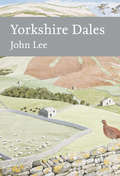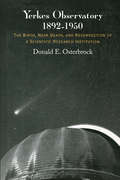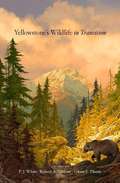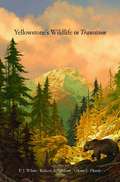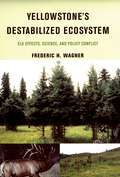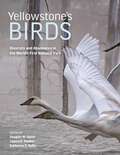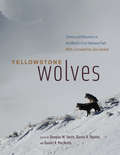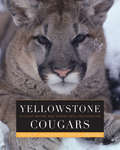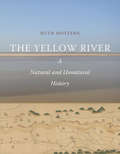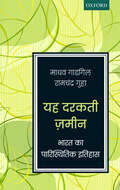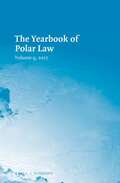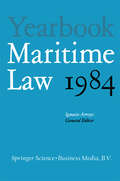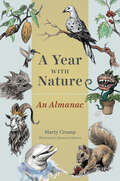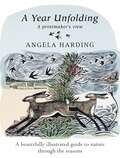- Table View
- List View
Yorkshire Dales: Collins New Naturalist Library (Collins New Naturalist Library #130)
by John LeeA definitive natural history of the Yorkshire Dales, covering the range of wildlife habitats, rich cultural heritage and ecological history of one of our best-loved National Parks.
Yew tree (UEB Uncontracted)
by Rnib BookshareIn this image of a yew tree, the trunk stems from the bottom centre of the page and the leafy branches are in the bottom half of the page. There is a locator dot shown, which will be at the top left of the page when the image is the right way up. There is a picture of some yew needles in the top left and a picture of a yew berry in the top right of the page. The needle leaf stem is to the top right of the needles themselves. The berry is similarly positioned. For scale there is a 'stick man' representing the height of an adult person in the bottom right of the page. The yew is one of the three British native evergreen trees. It is slow growing and can reach the grand age of 2,000 years. It is often found growing in old churchyards. Its wood was used for making longbows. The fruit shown on the page is often called a berry but it is really a cup-shaped red coat or aril protecting a single naked seed. The leaves and seeds are very poisonous.
Yew tree (UEB Contracted)
by Rnib BookshareIn this image of a yew tree, the trunk stems from the bottom centre of the page and the leafy branches are in the bottom half of the page. There is a locator dot shown, which will be at the top left of the page when the image is the right way up. There is a picture of some yew needles in the top left and a picture of a yew berry in the top right of the page. The needle leaf stem is to the top right of the needles themselves. The berry is similarly positioned. For scale there is a 'stick man' representing the height of an adult person in the bottom right of the page. The yew is one of the three British native evergreen trees. It is slow growing and can reach the grand age of 2,000 years. It is often found growing in old churchyards. Its wood was used for making longbows. The fruit shown on the page is often called a berry but it is really a cup-shaped red coat or aril protecting a single naked seed. The leaves and seeds are very poisonous.
Yew tree (Large Print)
by Rnib BookshareIn this image of a yew tree, the trunk stems from the bottom centre of the page and the leafy branches are in the bottom half of the page. There is a locator dot shown, which will be at the top left of the page when the image is the right way up. There is a picture of some yew needles in the top left and a picture of a yew berry in the top right of the page. The needle leaf stem is to the top right of the needles themselves. The berry is similarly positioned. For scale there is a 'stick man' representing the height of an adult person in the bottom right of the page. The yew is one of the three British native evergreen trees. It is slow growing and can reach the grand age of 2,000 years. It is often found growing in old churchyards. Its wood was used for making longbows. The fruit shown on the page is often called a berry but it is really a cup-shaped red coat or aril protecting a single naked seed. The leaves and seeds are very poisonous.
Yeti: An Abominable History
by Graham HoylandWhat leads us to believe in monsters? What happens when we meet the brutal creatures of our nightmares?
Yerkes Observatory, 1892-1950: The Birth, Near Death, and Resurrection of a Scientific Research Institution (A\century Foundation Book Ser.)
by Donald E. OsterbrockDrawing on his experience as historian of astronomy, practicing astrophysicist, and director of Lick Observatory, Donald Osterbrock uncovers a chapter in the history of astronomy by providing the story of the Yerkes Observatory. "An excellent description of the ups and downs of a major observatory."—Jack Meadows, Nature "Historians are much indebted to Osterbrock for this new contribution to the fascinating story of twentieth-century American astronomy."—Adriaan Blaauw, Journal for the History of Astronomy "An important reference about one of the key American observatories of this century."—Woodruff T. Sullivan III, Physics Today
Yerkes Observatory, 1892-1950: The Birth, Near Death, and Resurrection of a Scientific Research Institution
by Donald E. OsterbrockDrawing on his experience as historian of astronomy, practicing astrophysicist, and director of Lick Observatory, Donald Osterbrock uncovers a chapter in the history of astronomy by providing the story of the Yerkes Observatory. "An excellent description of the ups and downs of a major observatory."—Jack Meadows, Nature "Historians are much indebted to Osterbrock for this new contribution to the fascinating story of twentieth-century American astronomy."—Adriaan Blaauw, Journal for the History of Astronomy "An important reference about one of the key American observatories of this century."—Woodruff T. Sullivan III, Physics Today
Yerkes Observatory, 1892-1950: The Birth, Near Death, and Resurrection of a Scientific Research Institution
by Donald E. OsterbrockDrawing on his experience as historian of astronomy, practicing astrophysicist, and director of Lick Observatory, Donald Osterbrock uncovers a chapter in the history of astronomy by providing the story of the Yerkes Observatory. "An excellent description of the ups and downs of a major observatory."—Jack Meadows, Nature "Historians are much indebted to Osterbrock for this new contribution to the fascinating story of twentieth-century American astronomy."—Adriaan Blaauw, Journal for the History of Astronomy "An important reference about one of the key American observatories of this century."—Woodruff T. Sullivan III, Physics Today
Yellowstone's Wildlife in Transition
by P. J. WhiteThe world's first national park is constantly changing. How we understand and respond to recent events putting species under stress will determine the future of ecosystems millions of years in the making. Marshaling expertise from over 30 contributors, Yellowstone's Wildlife in Transition examines three primary challenges to the park's ecology.
Yellowstone's Wildlife in Transition
by P. J. WhiteThe world's first national park is constantly changing. How we understand and respond to recent events putting species under stress will determine the future of ecosystems millions of years in the making. Marshaling expertise from over 30 contributors, Yellowstone's Wildlife in Transition examines three primary challenges to the park's ecology.
Yellowstone's Destabilized Ecosystem: Elk Effects, Science, and Policy Conflict
by Frederic H. WagnerWagner, one of our most distinguished wildlife biologists, is a strong critic of ecological practices in the national parks. This book provides an assessment of the ecological history of Yellowstone's northern range, since before the park existed, showing the impact of US Park Service policies on the health of the areas they oversee. He demonstrates that elk had been historically rare throughout the region and that overgrazing by elk has seriously degraded the landscape and altered the structure of the area. This is a major contribution to reconstructing the ecology of this region over the course of the past 500 years. It is also a critique of US Park Service management policies and their stewardship of the nation's most cherished natural areas. Wagner's book will generate substantial attention and debate both in the scientific and policy/management communities.
Yellowstone’s Birds: Diversity and Abundance in the World’s First National Park
by Douglas W. Smith Lauren E. Walker Katharine E. Duffy Robert K. LandisA beautifully illustrated survey of Yellowstone’s breathtaking birdlife, written by a team of renowned ornithologists and wildlife biologistsEstablished in 1872, Yellowstone National Park is the oldest and arguably the most famous national park in North America, attracting millions of visitors each year. While many come to the park for its recreational activities, the wildlife of Yellowstone is just as alluring. This book brings together more than 30 leading experts to provide the first comprehensive survey of the natural history, science, and conservation of birds in Yellowstone. Covering most bird species breeding within the great park as well as the many migrants that pass through, Yellowstone’s Birds is a scientific tour de force and an essential resource for visitors to Yellowstone and bird lovers everywhere.Tallies more than 200 species, including migrantsDescribes the natural history, status, and latest science on the birds of YellowstoneFeatures fact-filled, easy-to-read chapters, informative sidebar essays, maps, infographics, and photos that present current science in an easily understood wayAccompanied by videos by award-winning cinematographer Bob LandisDraws on a wealth of data on Yellowstone’s birds collected over many decadesWith contributions by many of today’s leading bird experts, this is a long-overdue survey of Yellowstone’s breathtaking avian fauna
Yellowstone Wolves: Science and Discovery in the World's First National Park (America's Animal Comebacks Ser.)
by Douglas W. Smith Daniel R. Stahler Daniel R. MacNultyIn 2020, it will have been twenty-five years since one of the greatest wildlife conservation and restoration achievements of the twentieth century took place: the reintroduction of wolves to the world’s first national park, Yellowstone. Eradicated after the park was established, then absent for seventy years, these iconic carnivores returned to Yellowstone in 1995 when the US government reversed its century-old policy of extermination and—despite some political and cultural opposition—began the reintroduction of forty-one wild wolves from Canada and northwest Montana. In the intervening decades, scientists have studied their myriad behaviors, from predation to mating to wolf pup play, building a one-of-a-kind field study that has both allowed us to witness how the arrival of top predators can change an entire ecosystem and provided a critical window into impacts on prey, pack composition, and much else. Here, for the first time in a single book, is the incredible story of the wolves’ return to Yellowstone National Park as told by the very people responsible for their reintroduction, study, and management. Anchored in what we have learned from Yellowstone, highlighting the unique blend of research techniques that have given us this knowledge, and addressing the major issues that wolves still face today, this book is as wide-ranging and awe-inspiring as the Yellowstone restoration effort itself. We learn about individual wolves, population dynamics, wolf-prey relationships, genetics, disease, management and policy, newly studied behaviors and interactions with other species, and the rippling ecosystem effects wolves have had on Yellowstone’s wild and rare landscape. Perhaps most importantly of all, the book also offers solutions to ongoing controversies and debates. Featuring a foreword by Jane Goodall, beautiful images, a companion online documentary by celebrated filmmaker Bob Landis, and contributions from more than seventy wolf and wildlife conservation luminaries from Yellowstone and around the world, Yellowstone Wolves is a gripping, accessible celebration of the extraordinary Yellowstone Wolf Project—and of the park through which these majestic and important creatures once again roam.
Yellowstone Wolves: Science and Discovery in the World's First National Park
In 2020, it will have been twenty-five years since one of the greatest wildlife conservation and restoration achievements of the twentieth century took place: the reintroduction of wolves to the world’s first national park, Yellowstone. Eradicated after the park was established, then absent for seventy years, these iconic carnivores returned to Yellowstone in 1995 when the US government reversed its century-old policy of extermination and—despite some political and cultural opposition—began the reintroduction of forty-one wild wolves from Canada and northwest Montana. In the intervening decades, scientists have studied their myriad behaviors, from predation to mating to wolf pup play, building a one-of-a-kind field study that has both allowed us to witness how the arrival of top predators can change an entire ecosystem and provided a critical window into impacts on prey, pack composition, and much else. Here, for the first time in a single book, is the incredible story of the wolves’ return to Yellowstone National Park as told by the very people responsible for their reintroduction, study, and management. Anchored in what we have learned from Yellowstone, highlighting the unique blend of research techniques that have given us this knowledge, and addressing the major issues that wolves still face today, this book is as wide-ranging and awe-inspiring as the Yellowstone restoration effort itself. We learn about individual wolves, population dynamics, wolf-prey relationships, genetics, disease, management and policy, newly studied behaviors and interactions with other species, and the rippling ecosystem effects wolves have had on Yellowstone’s wild and rare landscape. Perhaps most importantly of all, the book also offers solutions to ongoing controversies and debates. Featuring a foreword by Jane Goodall, beautiful images, a companion online documentary by celebrated filmmaker Bob Landis, and contributions from more than seventy wolf and wildlife conservation luminaries from Yellowstone and around the world, Yellowstone Wolves is a gripping, accessible celebration of the extraordinary Yellowstone Wolf Project—and of the park through which these majestic and important creatures once again roam.
Yellowstone Wildlife: Ecology and Natural History of the Greater Yellowstone Ecosystem
by Paul A. JohnsgardYellowstone Wildlife is a natural history of the wildlife species that call Yellowstone National Park and the Greater Yellowstone Ecosystem their home. Illustrated with stunning images by renowned wildlife photographer Thomas Mangelsen, Yellowstone Wildlife describes the lives of species in the park, exploring their habitats from the Grand Tetons to Jackson Hole. From charismatic megafauna like elk, bison, wolves, bighorn sheep, and grizzly bears, to smaller mammals like bats, pikas, beavers, and otters, to some of the 279 species of birds, Johnsgard describes the behavior of animals throughout the seasons, with sections on what summer and autumn mean to the wildlife of the park, especially with the intrusion of millions of tourists each year. Enhanced by Mangelsen’s wildlife photography, Yellowstone Wildlife reveals the beauty and complexity of these species’ intertwined lives and that of Yellowstone’s greater ecosystem.
Yellowstone Cougars: Ecology before and during Wolf Restoration
by Toni K. Ruth Polly C. Buotte Maurice G. HornockerYellowstone Cougars examines the effect of wolf restoration on the cougar population in Yellowstone National Park—one of the largest national parks in the American West. No other study has ever specifically addressed the theoretical and practical aspects of competition between large carnivores in North America. The authors provide a thorough analysis of cougar ecology, how they interact with and are influenced by wolves—their main competitor—and how this knowledge informs management and conservation of both species across the West. Of practical importance, Yellowstone Cougars addresses the management and conservation of multiple carnivores in increasingly human-dominated landscapes. The authors move beyond a single-species approach to cougar management and conservation to one that considers multiple species, which was impossible to untangle before wolf reestablishment in the Yellowstone area provided biologists with this research opportunity. Yellowstone Cougars provides objective scientific data at the forefront of understanding cougars and large carnivore community structure and management issues in the Greater Yellowstone Ecosystem, as well as in other areas where wolves and cougars are reestablishing. Intended for an audience of scientists, wildlife managers, conservationists, and academics, the book also sets a theoretical precedent for writing about competition between carnivorous mammals.
The Yellow River: A Natural and Unnatural History (Yale Agrarian Studies Series)
by Ruth MosternA three-thousand-year history of the Yellow River and the legacy of interactions between humans and the natural landscape From Neolithic times to the present day, the Yellow River and its watershed have both shaped and been shaped by human society. Using the Yellow River to illustrate the long-term effects of environmentally significant human activity, Ruth Mostern unravels the long history of the human relationship with water and soil and the consequences, at times disastrous, of ecological transformations that resulted from human decisions. As Mostern follows the Yellow River through three millennia of history, she underlines how governments consistently ignored the dynamic interrelationships of the river’s varied ecosystems—grasslands, riparian forests, wetlands, and deserts—and the ecological and cultural impacts of their policies. With an interdisciplinary approach informed by archival research and GIS (geographical information system) records, this groundbreaking volume provides unique insight into patterns, transformations, and devastating ruptures throughout ecological history and offers profound conclusions about the way we continue to affect the natural systems upon which we depend.
Yeh Darakti Zameen: Bharat ka Paristhitik Itihas
by Madhav GadgilThis Fissured Land, first published in 1992, presents an interpretative history ecological history of the Indian subcontinent. It offers a theory of ecological prudence and profligacy, testing this theory across the wide sweep of South Asian history. The book especially focuses on the use and abuse of forest resources. In Part One, the authors present a general theory of ecological history. Part Two provides a fresh interpretative history of pre-modern India along with an ecological interpretation of the caste system. In Part Three, the authors draw upon a huge wealth of source material in their socio-ecological analysis of the modes of resource use introduced in India by the British. This book is the Hindi edition translated from English.
The Yearbook of Polar Law: Volume 9, 2017 (The Yearbook Of Polar Law Ser. #9)
by Gudmundur Alfredsson Timo KoivurovaThe papers in this volume are based on presentations at ninth symposium in Akureyri in October 2016.
Yearbook Maritime Law: Volume I
by IgnacioArroyoI. The importance of legal questions related to the sea is obvious to everyone. It is hardly surprising that the subjects that make up international current events illustrate the leading role played by maritime affairs. Indeed, it is no coincidence that three quarters of the earth's surface is covered by oceans. Territorial seas, exclusive economic zones, exploitation of the seabed, fishing, transport, insurance, collision, and pollution raise many unresolved questions. On the other hand, the contrast of this importance with the modest attention that existing periodical publications merit must be underscored. Without undervaluing these publications, there has been a need for some time to create a vehicle of common expression, based on three central tenets: interdisciplinary framework, tendency towards uniform law, and both a theoretical and practical approach. a. A framework of interdisciplinary nature seems to be relevant as it is desirable to overcome the artificial separation between public and private law.
A Year with Nature: An Almanac
by Marty CrumpA Year with Nature is an almanac like none you’ve ever seen: combining science and aesthetics, it is a daily affirmation of the extraordinary richness of biodiversity and our enduring beguilement by its beauty. With a text by herpetologist and natural history writer Marty Crump and a cornucopia of original illustrations by Bronwyn McIvor, this quirky quotidian reverie gazes across the globe, media, and time as it celebrates date-appropriate natural topics ranging from the founding of the National Park Service to annual strawberry, garlic, shrimp, hummingbird, and black bear festivals. With Crump, we mark the publication of classics like Carson’s Silent Spring and White’s Charlotte’s Web, and even the musical premiere of Tchaikovsky’s Swan Lake. We note the discovery of the structure of DNA and the mountain gorilla, the rise of citizen science projects, and the work of people who’ve shaped how we view and protect nature—from Aristotle to E. O. Wilson. Some days feature US celebrations, like National Poinsettia Day and National Cat Day; others highlight country-specific celebrations, like Australia’s Wombat Day and Thailand’s Monkey Buffet Festival, during which thousands of macaques feast on an ornately arranged spread of fruits and vegetables. Crump also highlights celebrations that span borders, from World Wildlife Conservation Day to International Mountain Day and global festivities for snakes, sea turtles, and chocolate. Interweaving fascinating facts on everything from jellyfish bodies to monthly birth flowers with folkloric entries featuring the Loch Ness Monster, unicorns, and ancient Greek, Roman, and Egyptian mythology, the almanac is as exhaustive as it is enchanting. A Year with Nature celebrates the wonder and beauty of our natural world as we have expressed it in visual arts, music, literature, science, natural history, and everyday experience. But more than this, the almanac’s vignettes encourage us to contemplate how we can help ensure that future generations will be able to enjoy the landscapes and rich biodiversity we so deeply cherish.
A Year with Nature: An Almanac
by Marty CrumpA Year with Nature is an almanac like none you’ve ever seen: combining science and aesthetics, it is a daily affirmation of the extraordinary richness of biodiversity and our enduring beguilement by its beauty. With a text by herpetologist and natural history writer Marty Crump and a cornucopia of original illustrations by Bronwyn McIvor, this quirky quotidian reverie gazes across the globe, media, and time as it celebrates date-appropriate natural topics ranging from the founding of the National Park Service to annual strawberry, garlic, shrimp, hummingbird, and black bear festivals. With Crump, we mark the publication of classics like Carson’s Silent Spring and White’s Charlotte’s Web, and even the musical premiere of Tchaikovsky’s Swan Lake. We note the discovery of the structure of DNA and the mountain gorilla, the rise of citizen science projects, and the work of people who’ve shaped how we view and protect nature—from Aristotle to E. O. Wilson. Some days feature US celebrations, like National Poinsettia Day and National Cat Day; others highlight country-specific celebrations, like Australia’s Wombat Day and Thailand’s Monkey Buffet Festival, during which thousands of macaques feast on an ornately arranged spread of fruits and vegetables. Crump also highlights celebrations that span borders, from World Wildlife Conservation Day to International Mountain Day and global festivities for snakes, sea turtles, and chocolate. Interweaving fascinating facts on everything from jellyfish bodies to monthly birth flowers with folkloric entries featuring the Loch Ness Monster, unicorns, and ancient Greek, Roman, and Egyptian mythology, the almanac is as exhaustive as it is enchanting. A Year with Nature celebrates the wonder and beauty of our natural world as we have expressed it in visual arts, music, literature, science, natural history, and everyday experience. But more than this, the almanac’s vignettes encourage us to contemplate how we can help ensure that future generations will be able to enjoy the landscapes and rich biodiversity we so deeply cherish.
A Year with Nature: An Almanac
by Marty CrumpA Year with Nature is an almanac like none you’ve ever seen: combining science and aesthetics, it is a daily affirmation of the extraordinary richness of biodiversity and our enduring beguilement by its beauty. With a text by herpetologist and natural history writer Marty Crump and a cornucopia of original illustrations by Bronwyn McIvor, this quirky quotidian reverie gazes across the globe, media, and time as it celebrates date-appropriate natural topics ranging from the founding of the National Park Service to annual strawberry, garlic, shrimp, hummingbird, and black bear festivals. With Crump, we mark the publication of classics like Carson’s Silent Spring and White’s Charlotte’s Web, and even the musical premiere of Tchaikovsky’s Swan Lake. We note the discovery of the structure of DNA and the mountain gorilla, the rise of citizen science projects, and the work of people who’ve shaped how we view and protect nature—from Aristotle to E. O. Wilson. Some days feature US celebrations, like National Poinsettia Day and National Cat Day; others highlight country-specific celebrations, like Australia’s Wombat Day and Thailand’s Monkey Buffet Festival, during which thousands of macaques feast on an ornately arranged spread of fruits and vegetables. Crump also highlights celebrations that span borders, from World Wildlife Conservation Day to International Mountain Day and global festivities for snakes, sea turtles, and chocolate. Interweaving fascinating facts on everything from jellyfish bodies to monthly birth flowers with folkloric entries featuring the Loch Ness Monster, unicorns, and ancient Greek, Roman, and Egyptian mythology, the almanac is as exhaustive as it is enchanting. A Year with Nature celebrates the wonder and beauty of our natural world as we have expressed it in visual arts, music, literature, science, natural history, and everyday experience. But more than this, the almanac’s vignettes encourage us to contemplate how we can help ensure that future generations will be able to enjoy the landscapes and rich biodiversity we so deeply cherish.
A Year with Nature: An Almanac
by Marty CrumpA Year with Nature is an almanac like none you’ve ever seen: combining science and aesthetics, it is a daily affirmation of the extraordinary richness of biodiversity and our enduring beguilement by its beauty. With a text by herpetologist and natural history writer Marty Crump and a cornucopia of original illustrations by Bronwyn McIvor, this quirky quotidian reverie gazes across the globe, media, and time as it celebrates date-appropriate natural topics ranging from the founding of the National Park Service to annual strawberry, garlic, shrimp, hummingbird, and black bear festivals. With Crump, we mark the publication of classics like Carson’s Silent Spring and White’s Charlotte’s Web, and even the musical premiere of Tchaikovsky’s Swan Lake. We note the discovery of the structure of DNA and the mountain gorilla, the rise of citizen science projects, and the work of people who’ve shaped how we view and protect nature—from Aristotle to E. O. Wilson. Some days feature US celebrations, like National Poinsettia Day and National Cat Day; others highlight country-specific celebrations, like Australia’s Wombat Day and Thailand’s Monkey Buffet Festival, during which thousands of macaques feast on an ornately arranged spread of fruits and vegetables. Crump also highlights celebrations that span borders, from World Wildlife Conservation Day to International Mountain Day and global festivities for snakes, sea turtles, and chocolate. Interweaving fascinating facts on everything from jellyfish bodies to monthly birth flowers with folkloric entries featuring the Loch Ness Monster, unicorns, and ancient Greek, Roman, and Egyptian mythology, the almanac is as exhaustive as it is enchanting. A Year with Nature celebrates the wonder and beauty of our natural world as we have expressed it in visual arts, music, literature, science, natural history, and everyday experience. But more than this, the almanac’s vignettes encourage us to contemplate how we can help ensure that future generations will be able to enjoy the landscapes and rich biodiversity we so deeply cherish.
A Year Unfolding: A Printmaker's View
by Angela HardingA beautifully illustrated guide to nature through the seasons by much-loved printmaker Angela Harding.The cover of this stunning book has an exclusive triptych printed on the reverse - a perfect collector's itemThis stunning work, the first book that is solely dedicated to Angela's art, is a celebration of her beautiful prints, and a glimpse into her detailed and meticulous process.A Year Unfolding is a journey through Angela's year in nature watching the seasons unfold in front of her from her studio in Rutland, and giving the reader detail into how nature transforms and evolves over the course of the year.A Year Unfolding also tells the stories behind some of Angela's most popular images, giving context to Angela's celebrated work, as well as new art created specifically for the book.The beautiful illustrations and evocative imagery of the prose make this the perfect book for Angela's fans and readers and art lovers everywhere.Angela has created the covers for many bestselling books, including The Salt Path and The Wild Silence by Raynor Winn, October, October by Katya Balen, English Pastoral by James Rebanks, Christmas is Murder by Val McDermid and RSPB Birds among many others.
